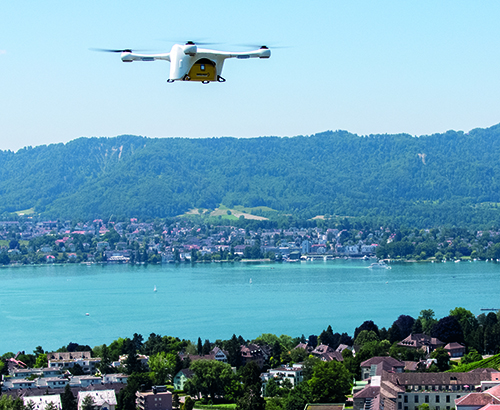Crash into Lake Zurich of American-made drone carrying blood specimens is first setback for pioneering Swiss Post medical drone program
Medical drones shuttling clinical laboratory specimens across open terrain is an exciting reality that Dark Daily has reported on in previous e-briefings. However, the medical drone revolution experienced a setback in January when drone-pioneer Swiss Post (Switzerland’s postal service) saw one of its American-made Matternet drones crash into Lake Zurich, Switzerland.
According to a Swiss Post news release, the drone went down carrying a “non-vital” blood sample (one that had been previously analyzed). The flight was part of a recently launched pilot program transporting blood samples between Zurich’s central laboratory and the Hirslanden Klinik Im Park, a private clinic on the opposite side of Lake Zurich.
A drone can cover the 5.8-kilometres across the water in seven minutes—five times faster than an on-the-road courier, according to Swiss Post.
Zurich city police recovered the drone from the lake on January 28. However, until the cause of the accident is determined, Swiss Post has grounded all drone flights, the news release noted.
This was the first accident involving Swiss Post drones, which have successfully completed more than 3,000 flights in Lugano, Berne, and Zurich.

Christian Hegner, Director General of Switzerland’s Federal Office of Civil Aviation, is proud of his country’s contribution to the development of performance-based regulatory models for the drone industry, which are detailed in the World Economic Forum (WEF) Advanced Drone Operations Toolkit. “The goal of this toolkit is to enable regulators to learn from the innovative policy experiments occurring around the world and empower them to adopt these governance models that accelerate the promise of drones for all,” he states in the toolkit.
“We have learned a lot in the last few years,” Hegner told SWI swissinfo.ch (SWI), the international reporting service of the Swiss Broadcasting Corporation (SBC). “Sharing our expertise and learning from other countries will help speed up and extend drone security around the world.”

Timothy Reuter, Head of Drones and Tomorrow’s Airspace at the World Economic Forum, and co-author of the Advanced Drone Operations Toolkit, believes it is only a matter of time before ecommerce and medical drones rule the skies. “We are witnessing the beginning of a logistics revolution; one that will redefine the way goods and people are moved around the world, and one that will drive social change alongside societal impact,” he states in the Advanced Drone Operation Toolkit. (Photo copyright: Quartz.]
Might Medical Drones in the US Carry Clinical Laboratory Samples?
Now that the World Economic Forum has issued its “toolkit,” which is aimed at helping countries replicate the pioneering success of Switzerland and Rwanda in transporting blood and other medical specimens using unmanned aerial vehicles (drones), could the use of medical transport drones to deliver clinical laboratory specimens throughout the US could take off as well?
Maybe. Creation of such a medical transport network using drones faces headwinds from aviation industry regulators.
According to National Public Radio (NPR), the Federal Aviation Administration (FAA) has expressed concerns about authorizing the widespread use of drones in already congested airspace.
“We haven’t seen the [FAA] be interested in a one-off approach,” Susan Roberts, PhD, told NPR. Roberts is Global Commercial Head of Innovation and Sales Excellence for Panasonic Avionics, and founder and former policy leader at AiRXOS, a General Electric subsidiary focused on drone infrastructure technology. “It doesn’t do anybody any good for a delivery company to be able to fly from two specific points if they can’t then scale that over and over again,” she noted.
Nevertheless, in its Advanced Drone Operations Toolkit, the WEF argues a “unique opportunity exists today to harness the revolutionary power of drones and autonomous aerial mobility,” and it provides a regulatory framework to do so.
The crash of the Swiss Post drone carrying clinical laboratory samples is a setback. However, it is also a learning experience. As Swiss Post and other nations gain experience, and as regulatory models become established, anatomic pathology groups and medical laboratories worldwide may finally have a solution for delivering specimens over long distances while maintaining the integrity of samples.
—Andrea Downing Peck
Related Information:
Drone Carrying Blood Falls in Lake During Testing
Crashed Swiss Post Drone Recovered
Advanced Drone Operations Toolkit: Accelerating the Drone Revolution
Drones: Swiss Post to Regularly Transport Lab Samples Across the Zurich Lake Basin in Future
Medical Cargo Could be the Gateway for Routine Drone Deliveries
Drones Used to Deliver Clinical Laboratory Specimens in Switzerland



